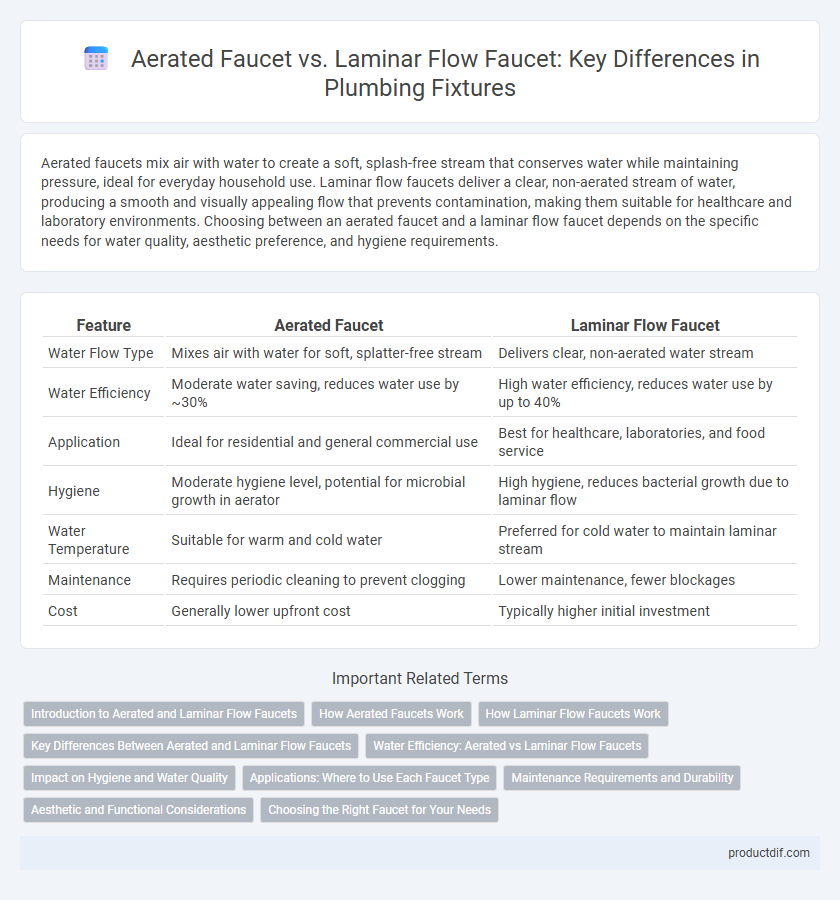Aerated faucets mix air with water to create a soft, splash-free stream that conserves water while maintaining pressure, ideal for everyday household use. Laminar flow faucets deliver a clear, non-aerated stream of water, producing a smooth and visually appealing flow that prevents contamination, making them suitable for healthcare and laboratory environments. Choosing between an aerated faucet and a laminar flow faucet depends on the specific needs for water quality, aesthetic preference, and hygiene requirements.
Table of Comparison
| Feature | Aerated Faucet | Laminar Flow Faucet |
|---|---|---|
| Water Flow Type | Mixes air with water for soft, splatter-free stream | Delivers clear, non-aerated water stream |
| Water Efficiency | Moderate water saving, reduces water use by ~30% | High water efficiency, reduces water use by up to 40% |
| Application | Ideal for residential and general commercial use | Best for healthcare, laboratories, and food service |
| Hygiene | Moderate hygiene level, potential for microbial growth in aerator | High hygiene, reduces bacterial growth due to laminar flow |
| Water Temperature | Suitable for warm and cold water | Preferred for cold water to maintain laminar stream |
| Maintenance | Requires periodic cleaning to prevent clogging | Lower maintenance, fewer blockages |
| Cost | Generally lower upfront cost | Typically higher initial investment |
Introduction to Aerated and Laminar Flow Faucets
Aerated faucets mix air with water to create a soft, bubbly flow that reduces water usage while maintaining pressure, making them ideal for everyday residential use. Laminar flow faucets produce a clear, non-aerated stream by forcing water through parallel channels, which minimizes splashing and contamination, favored in healthcare and laboratory settings. Both faucet types enhance water efficiency but differ significantly in their flow characteristics and applications.
How Aerated Faucets Work
Aerated faucets mix air with water flow, creating a soft, non-splashing stream that reduces water consumption while maintaining pressure. This mixing enhances the user experience by providing a steady flow that feels full despite using less water. The aeration process also helps in minimizing water waste and improving overall efficiency in plumbing fixtures.
How Laminar Flow Faucets Work
Laminar flow faucets deliver water through multiple small parallel streams, creating a smooth, non-splashing flow ideal for hygiene-sensitive environments. Using a laminar flow device, these faucets minimize water turbulence and reduce the presence of airborne contaminants. This precise water delivery method enhances user comfort while conserving water and improving sanitation standards in commercial and medical facilities.
Key Differences Between Aerated and Laminar Flow Faucets
Aerated faucets mix air with water to create a soft, bubbly stream that reduces splashing and conserves water, making them ideal for residential use. Laminar flow faucets produce a clear, non-aerated, smooth water stream that minimizes aerosol dispersion, which is essential in healthcare and laboratory settings for hygiene purposes. The key differences lie in their water flow characteristics, splash reduction methods, and specific application environments.
Water Efficiency: Aerated vs Laminar Flow Faucets
Aerated faucets mix air with water to create a softer, splash-free stream while maintaining water efficiency by reducing flow rates without compromising pressure. Laminar flow faucets deliver a clear, non-aerated stream that prevents splash but may use slightly more water than aerated models due to the absence of air mixing. Choosing between aerated and laminar flow faucets depends on balancing water conservation with specific application needs, as aerated faucets typically achieve higher water efficiency in general-use environments.
Impact on Hygiene and Water Quality
Aerated faucets mix air with water, reducing splashing and conserving water while maintaining adequate hygiene by minimizing bacterial growth through proper water flow. Laminar flow faucets provide a clear, non-aerated stream that prevents aerosolization, reducing the risk of cross-contamination and enhancing water quality by delivering uncontaminated water directly. In environments demanding high hygiene standards such as healthcare, laminar flow faucets are preferred for their ability to limit bacterial spread and ensure superior water purity.
Applications: Where to Use Each Faucet Type
Aerated faucets are ideal for residential kitchens and bathrooms, providing a mix of air with water to reduce splashing and conserve water while ensuring a soft, voluminous stream. Laminar flow faucets are preferred in healthcare, laboratories, and commercial settings where maintaining sterile, splash-free water flow without air bubble contamination is critical. Selecting the appropriate faucet depends on specific application requirements related to hygiene standards and water usage efficiency.
Maintenance Requirements and Durability
Aerated faucets require frequent maintenance due to mineral buildup in the aerator screen, which can reduce water flow and cause clogs, while laminar flow faucets have a simpler internal design that minimizes clogging and demands less frequent cleaning. The durability of laminar flow faucets is generally higher because they have fewer small components susceptible to wear from sediment and minerals. Regular maintenance of aerated faucets is essential to sustain performance, whereas laminar flow faucets tend to maintain consistent operation with minimal upkeep.
Aesthetic and Functional Considerations
Aerated faucets mix air with water, creating a soft, bubbly stream that reduces splashing and enhances water savings, ideal for residential bathrooms and kitchens with an emphasis on comfort and efficiency. Laminar flow faucets deliver a clear, non-aerated stream of water, providing a sleek, modern aesthetic favored in commercial or high-design spaces where water clarity and precision are essential. Functionally, aerated faucets excel in reducing water usage, while laminar flow faucets prioritize hygiene and splash-free performance, making each suitable for distinct application needs.
Choosing the Right Faucet for Your Needs
Aerated faucets mix water with air to create a soft, splash-free stream ideal for everyday tasks and water conservation, making them suitable for residential use. Laminar flow faucets produce a clear, non-aerated stream that prevents contamination and is preferred in medical or laboratory environments where hygiene is critical. Selecting the right faucet depends on usage context, with aerated models optimizing comfort and efficiency, while laminar faucets prioritize precision and cleanliness.
Aerated Faucet vs Laminar Flow Faucet Infographic

 productdif.com
productdif.com